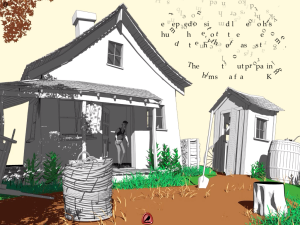Of course, the idea of an interactive book isn't entirely new. We've had electronic books for decades, those in which a battery operated toy would read aloud a story or respond to a child's touch. And open-ended and reader-controlled narratives aren't that novel either, as anyone who read the classic Choose-Your-Own-Adventure series will attest.
But e-books have the potential to far surpass these early examples, offering stories that respond to each reader individually, that offer truly open-ended narratives, and that really challenge what we mean when we think of a piece of writing that is "contained" in a book.
Indeed, many of the new and innovative examples of children's e-books aren't sold as books per se. They're available as websites, such as Inanimate Alice, or they're sold as apps, such as Moving Tales' most recent e-book Unwanted Guest, available for the iPhone and iPad.
Unwanted Guest takes a traditional folktale and updates it with charming 3D animations that accompany each page of the story. You can have the app auto-turn the pages, or flip yourself, or use the iPad's accelerometer to animate the text. The app offers a narration, but you also have the option to turn off the text and/or to add your own voice-over. You can listen and read in Spanish or French, as well as in English. And the story has randomly selected alternate views and extras so that it can be slightly different each time you read through it.
The app -- the e-book, or whatever it will be called -- will probably not be the definitive future of children's literature. There's nothing that links a reader to the outside world. There's no way to share content or comments, for example, or to research the origins of the traditional folktale online. The story, although told (and retold) creatively -- is still self-contained within the app. And while there are ways to slightly shift the story, it isn't entirely new or open-ended or up for revision.
Still, Unwanted Guest does point towards the ways in which authors may write (and draw and animate and program) children's literature in the future.
Check out the demo video:
http://www.youtube.com/watch?v=UwzSFEUeCfY&feature=player_embedded#at=77


